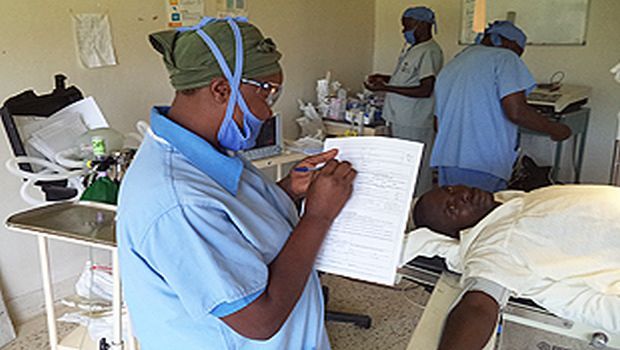Closing OR Doors Stops Deadly Surgical Site Infections in Uganda
In Uganda, taking a bath before surgery, closing the door to the operating theater and ensuring surgeons clean their hands properly can be the difference between life and death. A study involving more than 650 surgical patients, showed the rate of infections halved after new measures were introduced. As a result, patients are spending less time in hospital, resulting in cost-savings for both the patient and the hospital.


Preparation for surgery at Kisiizi Hospital in Uganda. Courtesy of G. Okumu/Kisiizi Hospital
In Uganda, taking a bath before surgery, closing the door to the operating theater and ensuring surgeons clean their hands properly can be the difference between life and death. A study involving more than 650 surgical patients, showed the rate of infections halved after new measures were introduced. As a result, patients are spending less time in hospital, resulting in cost-savings for both the patient and the hospital.
At Kisiizi Hospital in Uganda’s southwest, a World Health Organization program to reduce the risk of life-threatening infections for patients who undergo surgery is helping to turn the tide with some remarkably simple changes.
Closing the doors to operating theaters, reducing the number of people in theatre, limiting traffic in and out of theatre, and ensuring patients bathe before surgery, are all helping to reduce the number of infections in surgical patients. Other measures include improving surgical skin preparation by using a locally produced alcohol-based antiseptic and waiting for the skin to dry before incision, and using appropriate surgical antibiotic prophylaxis.
The results are encouraging. In a 2014 study involving more than 650 surgical patients, the rate of infections halved after the new measures were introduced. As a result, patients are spending less time in hospital, resulting in a cost savings both to them and to the hospital.
“Patients used to spend a lot of time and money, and a lot of healthcare workers’ time was spent on management of surgical site infections,” said Gabriel Okumu, Kisiizi Hospital’s general surgeon. “The change has been remarkable.”
Surgical site infections are the most common healthcare-associated infections in low-and middle-income countries, affecting up to one-third of patients who undergo surgery.
Kisiizi’s three surgeons, five junior doctors and eight intern doctors perform about 2,500 operations a year, including Caesarean sections, prostate surgery, hernia operations and even craniotomies. Each presents the risk of a surgical site infection.
“A few simple steps can prevent many of these infections,” said Dr. Wondi Alemu, WHO’s representative in Uganda. “Not only does that spare patients needless suffering, it’s also a substantial cost-saving to families, hospitals and Uganda’s health system.”
Hand hygiene is one of the key measures for ensuring infections are minimized. On May 5 every year, Hand Hygiene Day, all 300 members of Kisiizi’s staff receive training to help them care safely for patients with peripheral lines, central lines, endotracheal tubes and urinary catheters.
The staff also go out to schools and community health centers to promote hand hygiene in the community.
Kisiizi is one of five African hospitals participating in WHO’s Surgical Unit-based Safety Program, which aims to reduce surgical site infections at hospitals in Kenya, Uganda, Zambia and Zimbabwe. As part of the program, Kisiizi has been “twinned” with Countess of Chester Hospital in the United Kingdom, which provides patient safety mentoring. The program builds on the African Partnership for Patient Safety, which began in 2009.
Apart from reducing the number of infections, Kisiizi’s doctors have also reduced the unnecessary use of antibiotics after surgery, helping to prevent the development of antibiotic resistance. About 24 percent of patients now receive post-operative antibiotics, down from 93% before the new measures were introduced.
“Hand hygiene has been a critical part of the success at Kisiizi,” said Dr. Benedetta Allegranzi, who leads SUSP at WHO in Geneva. “The fact that they produced their own alcohol-based handrub is even more impressive.”
While the numbers are encouraging, the true measure of success will be a lasting change in infection prevention practices at the hospital, said Sarah Hoyle, who manages the program for Countess of Chester Hospital.
“One of the things we’re interested in is cultural change,” she said. “We carry out regular staff questionnaires to see what effects the partnership has had and to assess whether there has been a change of culture in terms of patient safety.”
Source: WHO
Newsletter
Stay prepared and protected with Infection Control Today's newsletter, delivering essential updates, best practices, and expert insights for infection preventionists.